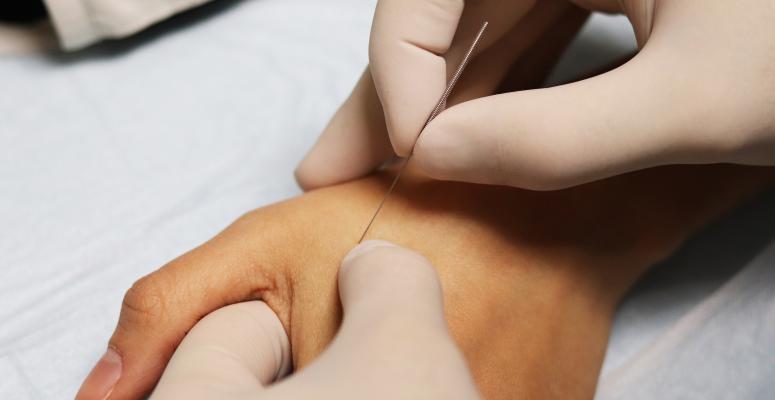
If you’ve ever seen pictures of a dry needling session, you may feel intimidated by the prospect of many tiny needles being inserted into your skin. Fortunately, dry needling is so much more than that. It’s a process used to provide relief to those experiencing a variety of myofascial conditions and trigger points. Dry needling is often compared to acupuncture; however, acupuncture focuses on improving the body’s energy. Dry needling’s focus is relieving pain and tension under the skin. Dry needling is a practice often used by physical therapists to improve their patients' myofascial pain and increase functionality. Here’s what else you should know about dry needling.
What conditions can dry needling be used to treat?
There are a variety of conditions that can specifically be improved with dry needling during physical therapy. Some of these conditions include:
- Joint pain — Joint pain is a term used to describe a condition where the joints are painful, stiff, swollen, numb or uncomfortable. The pain may be chronic or may occur after an overuse injury. Many people with arthritis, bursitis and muscle conditions experience joint pain. This type of pain often feels worse after inactivity, particularly after sleeping.
- Tendinitis — Tendinitis is another condition that can be improved with dry needling. This condition involves inflammation of the tendons, which connect the muscles to the bones in your body. When the tendons become inflamed, they can cause pain and sensitivity during movement.
- TMJ dysfunction — Temporomandibular joint (TMJ) dysfunction is characterized by pain and discomfort in the jaw joint and the surrounding tissue when moving the jaw joint. This condition can cause significant pain in the jaw, discomfort during movement, trouble speaking or chewing, and clicking or popping sounds. TMJ dysfunction can also cause pain and discomfort in the head, neck, and shoulders.
- Muscle tension — Muscle tension is another condition that can be helped with dry needling. Tension can result from overuse, stress, inactivity and poor sleeping positions. Bands of tight muscle can form into knots and cause discomfort in a localized area.
- Nerve compression — A compressed nerve, also called a pinched nerve, is a condition that occurs when pressure is placed against a nerve in the body. This pressure is usually applied by bone, cartilage, tendons or muscle. Depending on the cause of the compressed nerve, dry needling may be able to improve this condition.
What are the benefits of dry needling?
Are you familiar with the plethora of benefits that dry needling can provide? Some of them include:
- Reduced muscle tension — One of the first benefits that dry needling during physical therapy can provide is reduced tightness and rigidity in the muscles. Dry needling can promote circulation throughout the body to release much of the tension in the body’s muscles.
- Increased blood flow — Another perk of dry needling is that it can be used to increase blood flow to a specific area of the body. Physical therapists can use dry needling to bring greater levels of blood flow to an injury or area of inflammation.
- Lower pain levels — Physical therapists use dry needling to treat people who are experiencing pain and discomfort from an injury or chronic condition. The body’s response to the needles is to increase blood flow, as mentioned above, which encourages the healing process and reduces long-term pain.
- Reduced inflammation — Dry needling in a physical therapy clinic is often used for the purpose of reducing inflammation. Since the needles increase blood flow wherever they’re placed, they can be used to reduce inflammation around an area of injury.
- Improved range of motion — An added benefit of dry needling during PT treatment is that it can be used to improve mobility. More specifically, it can improve the range of motion in an area of stiffness or inflammation. Whether you’re experiencing limited range of motion due to scar tissue or localized pain, dry needling’s blood-boosting qualities can help you regain motion in a targeted area of the body.
- Shorter recovery time — As if dry needling wasn’t a great treatment option already, physical therapists often use it to speed up a patient’s recovery period. The inflammatory response that the tiny, hollow needles trigger can help the body speed up the healing process. After the needles have been inserted, oxygen-filled blood rushes to the area. Increased oxygen-filled blood flow is the key to helping patients with all kinds of conditions and injuries reach recovery in less time.
Alliance PTP can connect you with a physical therapist who can provide dry needling
At Alliance Physical Therapy Partners, we’re proudly bringing together physical therapy practices across the country to help people get the high-quality PT they need.
Want to see a physical therapist in person? We can put you in touch with an Alliance PTP partner that’s close to you and that can help you address whether your condition may improve from dry needling or other PT treatment.
Come find help for your injury or chronic condition today!
Get Help at a Location Near You
